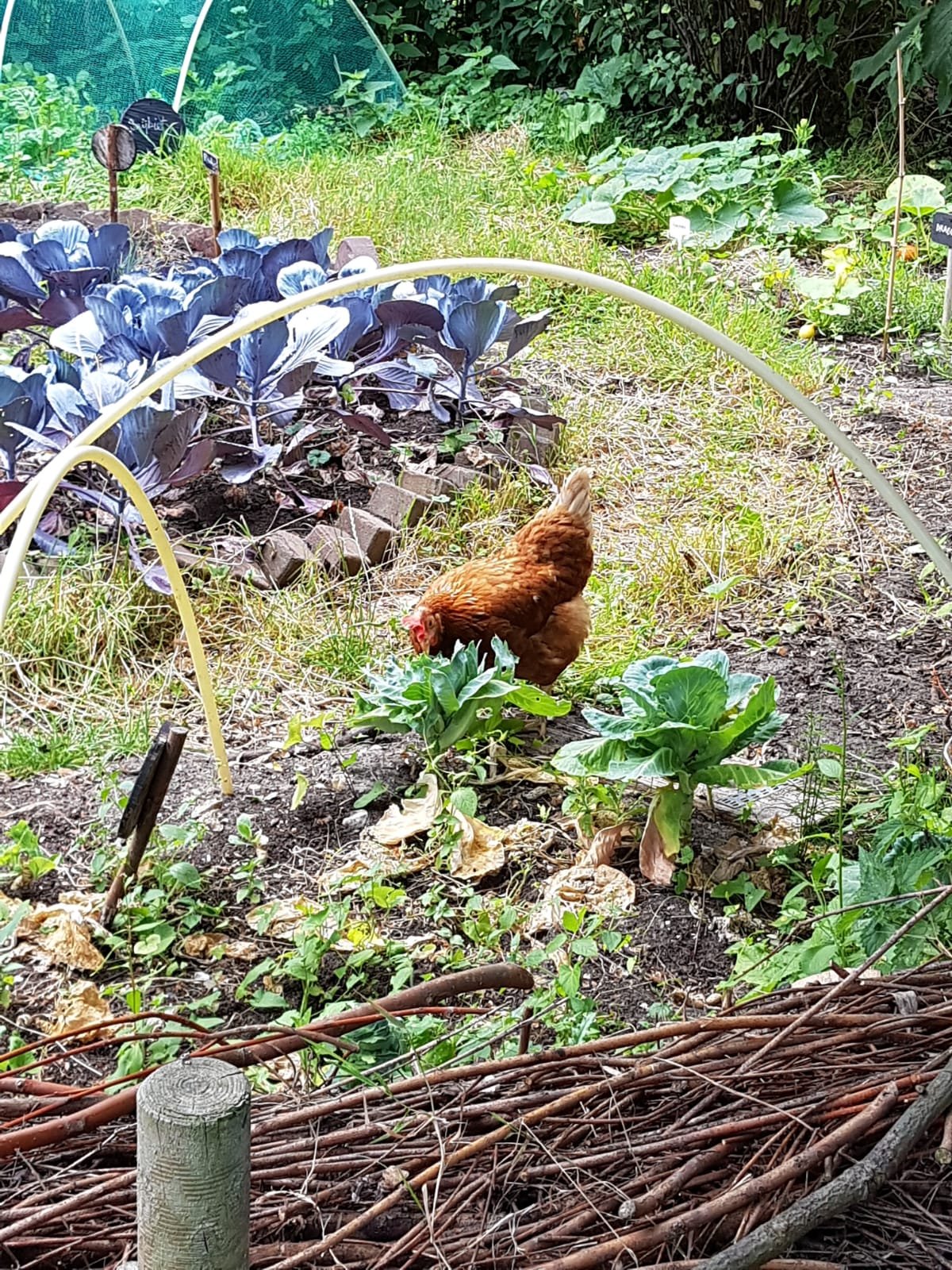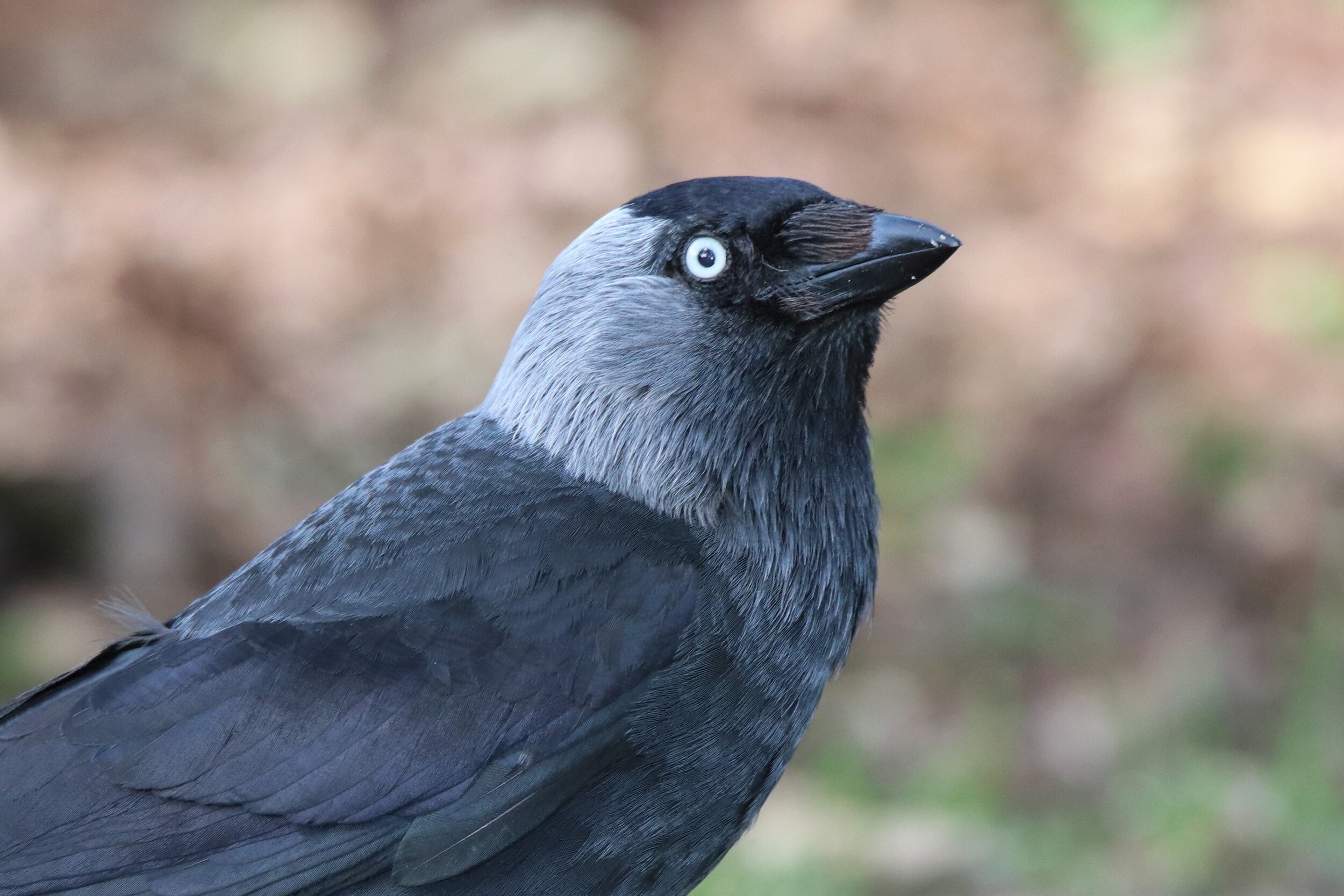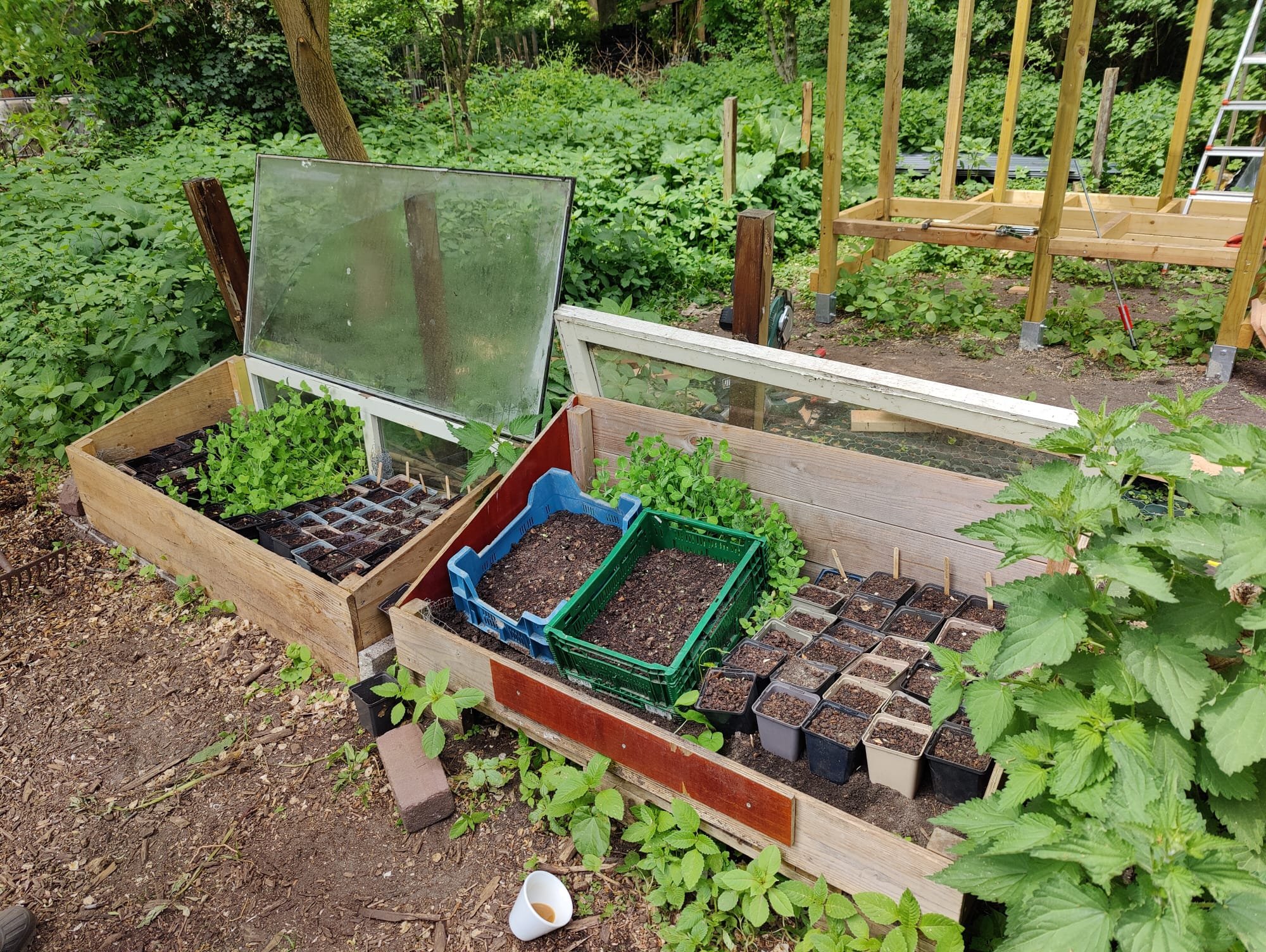Grow with us -4
Marauders in the garden
This season, at the Stadsboerderij Osdorp urban farm where we grow herbs, flowers and vegetables for the weekly community dinner, various marauders have required a lot of time, effort and cleverness from our garden team so far this season.
As the term ‘maurauders’ is not used in everyday conversation, it could very well be that you are looking forward to reading about an exciting and unfamiliar vegetable or wild plant in this post. Hopefully you are intrigued rather than disappointed to learn that ‘mauraders’ are in fact “those who roam from place to place looking for things to plunder or steal”.
Although this is certainly not the first year that we have been confronted with the raiding of our seeds and crops, this year has been particularly eventful. As permaculturists, we are strong believers in finding a natural balance in the garden, recreating an ecosystem where there is something for everyone to eat. In the middle of the city this is more difficult however, and some critters tend to thrive and multiply in urban settings which makes it hard to protect our vegetable crops. In this blog we will share some of our experiences this season and in seasons past. Perhaps our learnings will also be helpful for you!
Observe, reflect and then react
Some marauders are winged, observing your every move from the safety of a tree branch or rooftop until the moment you turn your back, at which point they swoop down to help themselves. Others hop or strut around, and still others tunnel stealthily under the ground and leave no trace of their thievery. Some work in broad daylight, and others creep around in the dark. So you will probably need to do some detective work in order to solve your specific garden crime.
We repeat the “observe, reflect and react” mantra often in our permaculture gardening classes when we talk about crop planning and dealing with the critters that also enjoy our plants. It’s important to gather clues to figure out exactly who is wreaking havoc in your garden and then to figure out what to do about it.
This year our biggest challenges have come from a wide variety of critters, including birds, chickens, rats, rabbits and even tiny ‘roly-poly’ insects. When you arrive at a crime scene, or better yet to prevent one entirely, you will want to do some research on the specific dietary preferences and habits of various local critters: do they like hard seeds (mice and rats) or rather fresh young seedlings (rabbits)? Do they work in the secrecy of the night or in broad daylight? Underground or above ground? Are plants being eaten or accidentally uprooted by the scratching or burrowing actions of creatures looking for insects above or below the ground?
Let me give an example. Teeth marks on the radishes? The ubiquitous rat is quickly blamed, but on closer inspection we observe that the marks are tiny and close to and even slightly under the soil. After lifting up some bricks we find the marauders: tiny little ‘roly-poly’ or pill bugs who leave their cool and moist dwellings at night to graze on radishes. The solution is straightforward: remove their hiding places near your veggies and they will relocate to moist climates somewhere else.
Pill bug, also known as a roly-poly bug
Photo: https://commons.wikimedia.org/wiki/File:Pill-bug_doodle-bug_potato-bug.jpg
Another example: when we repeatedly found our newly-sowed potatoes dug out of the soil and relocated in various places in the garden – with no teeth marks or any sign of nibbling – we first assumed that the chickens had escaped (a very common occurrence) and had uprooted the potatoes while scratching for insects. When it was confirmed that our fine feathered friends were still safely in their enclosure, the next suspects in line were the two adorable bunnies who have been frolicking merrily in the garden and nibbling on anything fresh and green they can sink their teeth into. We were reluctant to charge them as guilty however, as digging potatoes and leaving them spread around the garden seemed like a pointless activity for hungry rabbits. We were mighty surprised when we caught the culprits in broad daylight: a pair of jackdaws, the perky small crows with silverish heads, were sneakily uncovering the potatoes when our backs were turned and rolling them around for fun. It was only after digging the potatoes in deeper that we were able to put an end to this annoying but endearing behaviour.
Western jackdaw
Photo: Warrieboy, https://commons.wikimedia.org/w/index.php?curid=84360769
In the meantime, we’ve had the opportunity to learn more about these fun-loving and clever birds: they pair for life (also in same-sex pairs and thrupples), and they recognise individual human faces. They also eat slugs and their eggs. They’ve become a welcome part of our gardening experience, observing us from nearby branches and occasionally splashing energetically in the water pooled on the top of our garden tent.
Nope, this did not work! Rats gnawed through the chicken wire and plastic.
But this hammock of suspended seedlings was successful! They don’t like to crawl over swinging surfaces.
Marauders can be outsmarted – most of the time!
Once you have figured out who is eating – or playing with – your seeds and plants you can usually figure out a way to stop them. This year for example we have had a very hard time protecting our snow peas and fava beans. First we sowed them directly into the soil, and only realised after they didn’t come up that they had been consumed by rats via underground tunnels, leaving no trace of their disappearance at surface level. Next, we tried pre-sprouting the seeds in crates heavily protected with chicken wire, but the rats clearly had hugely enjoyed their underground feast and determinedly gnawed their way through the plastic crates for a second helping. We considered the tactic successfully used several years back – suspending seedlings in crates from the roof of the greenhouse – but we had far too many pumpkins, squash and sunflower seedlings for the upcoming Zonnebloemenprotest and Farmsterdammers weekend to safely hang.
Farm-made cold frames
Finally we resorted to growing our legumes in cold frames (above), which the rats were unable to penetrate. When the seedlings were about 20 centimeters high we twisted off the peas and bean seeds still attached to the plants as an extra precaution (this was recommended by a local farmer who finally won his battle to protect his legumes from rats) . And then we planted our babies out under wraps to keep them from the marauding rabbits, who we imagine would relish the tender young leaves. Hopefully the plants will be big and strong enough to stand free and protected within a couple of weeks; until then they are protected by a fortress of fleece (visiting children are very eager to play in here and maybe even have a sleepover).
Fleece to keep the rabbits away from the peas
As for the rabbits, we have spent a lot of time chasing them around the farm to try to figure out exactly where they were getting in. We have since installed some rubber under the entrance gate and hung up signs to encourage visitors to close the gates behind them which we hope has foiled them. But we know from our farmer colleagues at the nearby Pluk! CSA that rabbits are eager diggers and we will need to patrol the borders to the garden regularly until our seedlings are tall and strong enough to deter them.
Our chicken chasing days are also fewer and far between since we observed how a few of the most determined ladies were jumping onto posts inside their enclosure and squeezing through what seemed like impossibly tiny grates in some impressive Houdini-like escapes. Since we painstakingly wove string through all of these potential chicken exits we have not seen them in the garden. We console them in their captivity by bringing them extra juicy weeds.
Sometimes, however, the best plan of action is simply to give up on a specific crop. Last year, our garden team was bursting with pride about the perfect crop of kohlrabi that we had grown for the community dinner. They were a rich, vibrant purple, perched elegantly on their slender stems, with beautiful sea green leaves laced with red. We promised the kitchen that we would harvest a perfect crop for them of some 50 plants the following week. But when we arrived to harvest, we found a bloody battlefield: hollowed out kohlrabi shells, with scraps strewn carelessly across the field as if the marauders had been gorging so greedily they had not even bothered to chew. Closer inspection revealed tunnels opening up into the netted kohlrabi field. Seeing as the rats were also perfectly aware of when the kohlrabis were ripe, and given the enormous sense of disappointment we felt at their lack of restraint and failure to share with us, we decided to use our precious cabbage beds to grow other varieties – pointed cabbage and kale, for example – that the rats largely ignore.
Rats feasted on the kohlrabi before we could
Useful materials to have on hand
No matter the size of your garden, these materials are useful for crop protection:
Fleece: This is like a blanket for your crops, and when held down (for example with stones or big metal staples) it will also discourage birds and bunnies. It also has the advantage of creating a pleasant micro-climate for seedlings, protecting them from wind and cold. We recommend the biodegradable type so that you don’t end up putting more micro-plastics into the environment.
Net: Net is very useful to protect small cabbage plants from rabbits and birds (pigeons for example are crazy about cabbages). Mice and rats can squeeze right through, however. You can stretch it over willow branches or other bendy wood to keep it off the plants. We recommend buying good quality net that can last many years, and ideally in blue rather than black so that it is more visible to birds and other critters and they don’t get tangled up.
Cold frame: If you are having trouble protecting your germinating seeds or young seedlings from mice, rats or birds, we recommend building a cold frame. You can make one of these with very few materials, like this one from an old window and some garden tiles, or this one, which requires more carpentry skills. Cold frames are wonderful as they also let you extend your growing season (in many northern climates you can grow salad greens all winter long in a cold frame or start earlier in the spring).
Marauders put us to the test as resilient gardeners. Although it is tempting to throw in the towel when we lose plants or even an entire crop, it’s an important learning process if we take the time to observe, reflect and adapt to the situation. And the opportunity to learn more about the habits and dietary preferences of the animals with whom we share our garden ecosystem. In a good year, we should find that there is plenty to eat for all of us!
Coming up soon: slugs!
We have not spoken about one of the most feared marauders of all: slugs! Due to the current droughts we nearly forgot about them but we will take them up in a future blog post!
by Ann Doherty, City coordinator and GDGD teacher and former Pluk! CSA farmer












